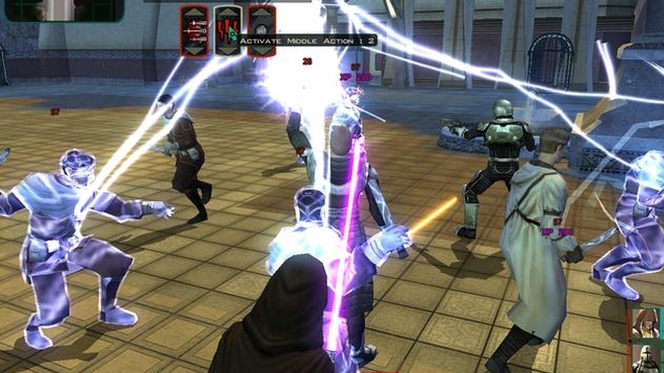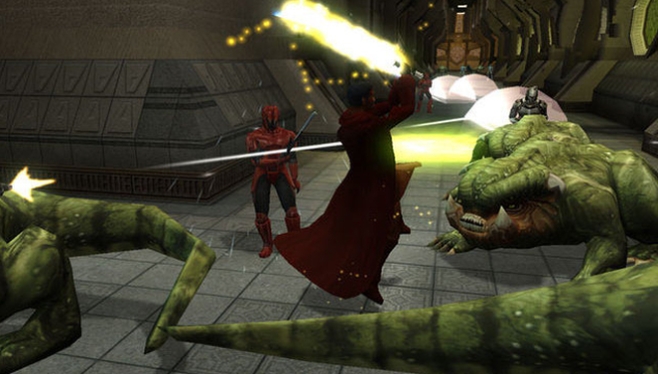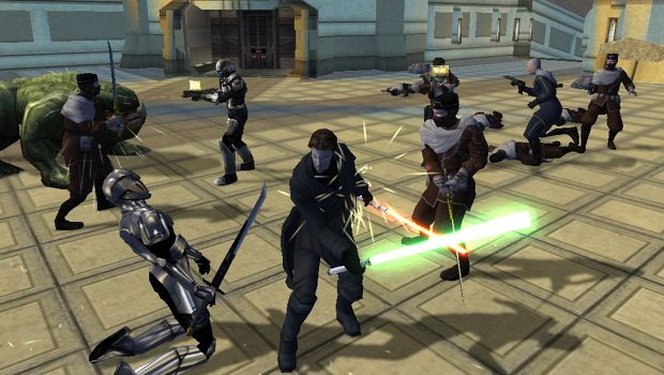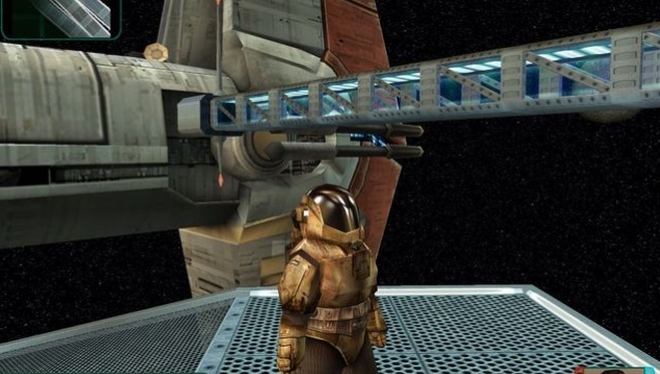RETRO – Galaxies have a way of keeping you on your toes: save them or doom them, and a few years later, trouble brews once again. The brand-new hero of KotOR II faces this reality when they awaken on a mining planet, stripped of their lightsaber and severed from the Force. It’s a long road ahead, but before the credits roll, our hero is destined to become the galaxy’s greatest Jedi—or perhaps its darkest Sith… The game turned 20 years old on December 6, 2024, and we updated this article to celebrate the occasion.
In 2003, the Force was undeniably with LucasArts. After years of inconsistent hits and misses, they delivered a role-playing game that became an instant classic for both seasoned RPG fans and newcomers alike. On Xbox, KotOR dominated in both sales and reception and for PC players, no RPG had come close to its brilliance since the release of Baldur’s Gate II.
I mentioned Baldur’s Gate II for a reason—it’s another gem brought to life by BioWare, the creators of KotOR. To this day, I’d argue that the Canadian studio remains unmatched in crafting RPG masterpieces. (Sadly, Troika Games’ Vampire: The Masquerade – Bloodlines failed to change my mind, but that’s a story for another time.)
That’s why I felt a twinge of worry upon learning that KotOR II wasn’t being developed by BioWare but rather by a newly formed studio, Obsidian Entertainment, comprised mostly of veterans from the old Black Isle team. Early screenshots and my E3 impressions assured me that the graphical engine and UI would remain largely untouched. The big question was whether the sequel’s quest design and story complexity could rival the high bar set by the original.
Outcast
KotOR II takes place 4,000 years before the events of the Star Wars films (okay, technically 3,995 years since it’s set five years after the original). The Jedi and Sith remain at each other’s throats, and despite our hero’s valiant efforts in the first game (assuming you chose the Light Side ending), the Jedi Order has been nearly annihilated by its ancient enemies.
Enter our protagonist, an exile—a fallen Jedi cast out by the Council’s upper echelons. A peaceful life of solitude à la Ben Kenobi or a quick descent into Sith allegiance might seem like logical options, but there’s a catch: our hero has been severed from the Force, their connection to it snuffed out like a depleted battery. To add insult to injury, they’ve lost their lightsaber and awaken in disgrace on a desolate mining planet.
Despite this predicament, the galaxy still views our hero as a Jedi, and this comes with a hefty price. Sith assassins, bounty hunters, and all manner of galactic scum are soon gunning for them. Thankfully, allies emerge along the way. Early in the game, we’re joined by Kreia, a mysterious old woman who gradually becomes our mentor. While reminiscent of Obi-Wan, Kreia’s layered personality and moral ambiguity set her apart—and this complexity only deepens as the story unfolds.
As the journey progresses, our crew expands, including a brash (and slightly annoying) pilot, a skilled assassin (or, depending on our moral alignment, a malevolent Wookiee), a handmaiden with a peculiar warrior philosophy, and even a blind Sith woman. Credit where it’s due: Obsidian surpassed even KotOR I in NPC development. Each companion is richly detailed and memorable.
That said, trust is hard to come by. Every ally has ulterior motives for joining us, and while they all profess loyalty, it’s hard to shake the feeling that any one of them might turn our own lightsaber against us in our sleep.
A Jedi Unlike Any Other
To prevent such betrayals, we must influence our companions to earn their trust. Similar to the original, each character has a personality gauge that tracks their moral alignment. But unlike before, KotOR II allows us to actively shift this alignment through dialogue choices. A single comment can elevate our standing in their eyes—or tarnish it.
Want to corrupt a virtuous companion or redeem a Sith Lord? KotOR II offers that flexibility. While these shifts rarely alter overarching story beats (traitorous companions will betray you regardless), building trust unlocks deeper character insights. Romance options also exist, though they require a keen understanding of dialogue to succeed.
I tried molding a Sith Lord out of the Handmaiden, a devoted Jedi servant. Cynical and ruthless responses racked up Dark Side points, but if I pushed too hard, she’d take offense and grow even more steadfast in her virtues. Ironically, this often resulted in unintended consequences, like her becoming a sanctimonious paragon of the Light Side.
Loved, Hated, Loved Again
While the influence system is a brilliant addition, it does have its flaws. For instance, certain scenarios make it nearly impossible to steer companions’ alignment in the desired direction. As someone determined to embrace the Dark Side, I aimed to collect as many Dark Side points as possible and drag everyone down with me, particularly the Handmaiden. Unfortunately, her responses to my cynicism often led to frustration. Instead of becoming a cold-hearted Sith, she transformed into a saintly figure—much to my dismay.
This disconnect between character development and narrative consistency also applied to romance options. Despite my best efforts, the Handmaiden’s attitude toward my character oscillated wildly. One moment she’d shower me with adoration; the next, she’d refuse to speak. It was both amusing and exasperating, a missed opportunity for a system that otherwise adds depth to interactions.
A Complex Web of Morality
The story of KotOR II is, in many ways, a double-edged lightsaber. Obsidian’s narrative excels in complexity and moral ambiguity, often challenging the player to question the Jedi Order’s inherent righteousness. Are the Jedi truly the galaxy’s saviors, or are the Sith justified in their actions? Even the Republic’s worthiness as a galactic authority comes under scrutiny, with certain planets arguably better off without its governance.
One particularly compelling moment takes place on a Naboo-like world embroiled in civil war. The decision to support the young queen or a rebellious general wasn’t black-and-white, as both had valid arguments. Playing as a Dark Side character, I ultimately backed the general after some deliberation, but aligning with the queen would have been just as defensible.
Our hero’s backstory further enriches the narrative. The Jedi Council’s decision to exile them is steeped in hypocrisy and questionable motives, leaving plenty of room for justified resentment. Even as a Dark Side champion, it’s hard to view our protagonist as a villain when their grievances are so relatable.
Philosophy for Jedi
Mentor Kreia adds another layer of intrigue with her philosophical musings and cryptic motives. Her scolding reactions to even seemingly logical decisions keep the player on their toes. Kreia’s stance—whether aligned with the Jedi, the Sith, or something in between—remains shrouded in mystery for much of the game, and her dynamic with the protagonist is one of KotOR II’s strongest points.
However, this narrative complexity sometimes backfires. Certain story arcs feel rushed, and some events lack coherence. One notable disappointment was the underwhelming death of a major antagonist, which felt unearned and anticlimactic, even on the hardest difficulty. It’s clear that Obsidian’s ambitions were constrained by development deadlines, leaving some threads unresolved.
Despite these shortcomings, the overall narrative remains one of the strongest in RPG history. With more time, KotOR II could have surpassed its predecessor in every way. As it stands, it’s a flawed masterpiece—a game that comes tantalizingly close to perfection.
Beauty and the (Technical) Beast
The rushed development cycle also left its mark on KotOR II’s visuals. Obsidian made minimal changes to the graphical engine, which was already showing its age by the end of 2003. While some character models received a slight facelift, the environments often felt bland and uninspired, particularly on planets where exploration was limited to sterile interior spaces.
Level design wasn’t always stellar, either. Navigating Nar Shaddaa’s repetitive corridors quickly became tiresome, though Onderon’s bustling city streets offered a refreshing contrast. The latter’s exotic atmosphere and more immersive layout helped bring the world to life, showcasing what the game could achieve at its best.
Unfortunately, the graphics are further marred by low-resolution textures—a clear holdover from the Xbox version. This issue is compounded by clunky animations, which fail to convey the gravitas of dramatic scenes. Watching characters collapse with exaggerated movements or deliver lines with stiff gestures occasionally breaks immersion.
On the bright side, Obsidian did make strides in character diversity. NPC faces no longer feel like carbon copies of one another, a notable improvement over KotOR I. Still, when compared to contemporary RPGs like Vampire: The Masquerade – Bloodlines, KotOR II’s visuals fall short.
Combat: Same Formula, New Flair
Obsidian wisely avoided tampering with KotOR’s combat system, a hybrid of real-time and turn-based mechanics that still holds up as one of the best in the genre. Borrowing from Baldur’s Gate, the system operates under the illusion of real-time action, with characters taking turns behind the scenes. This approach maintains tactical depth without overwhelming players.
The one significant addition is the introduction of Jedi combat styles. Once you reclaim your lightsaber, a dedicated menu lets you choose from various fighting techniques, each suited to specific scenarios. Whether fending off swarms of enemies or dueling a lone powerhouse, these styles add a layer of strategy to battles.
Additionally, the game introduces over 60 new abilities and Force powers, catering to a wide range of playstyles. Whether you favor blasters, vibroswords, lightsabers, or pure Force prowess, there’s something for everyone. However, the sheer strength of these abilities tips the balance heavily in the player’s favor, making even the hardest difficulty feel too forgiving.
A Galaxy Too Easily Conquered
While empowering, the game’s combat leans too far into power fantasy territory. Even Sith Lords—the supposed pinnacle of the Dark Side—pose little challenge. The final boss fight, for instance, felt more like an interactive dialogue sequence than an epic showdown. Defeating them required little more than spamming Force powers and watching their health bar melt away.
Even non-Force-sensitive characters in your party can steamroll through enemies with ease. Hanharr, the dark Wookiee, becomes an unstoppable force of nature when his berserker rage activates, tearing through opponents like a whirlwind of destruction. While undeniably fun, the lack of difficulty undermines the tension and stakes of combat.
“A Big Mac’s a Big Mac, but they call it ‘Le Big Mac…”
Despite its shortcomings, KotOR II shines in its attention to detail. Onderon, for example, feels alive with bustling streets, propaganda-spewing terminals, and even public protests. These small touches bring the game world to life, making it more immersive than its predecessor.
Another notable feature is the crafting system, which allows players to break down items into components to create new gear. While it’s mostly useful early on, the option adds a layer of resource management for those who enjoy tinkering.
Draw Your Lightsaber!
Ultimately, KotOR II falls just short of surpassing its predecessor, though it comes tantalizingly close. The culprit? A restrictive development timeline that left the game feeling rushed in places. Crafting a sequel to such a beloved and complex RPG in just one year was always an uphill battle.
The story, while brilliant, suffers from logical inconsistencies, a few poorly tied narrative threads, and a hastily executed conclusion. The climactic battle against the Sith Lord feels more like a missed opportunity than a proper finale. That said, even with its flaws, the story of KotOR II still eclipses most modern RPG narratives with its depth and ambition.
The lack of balance in gameplay is another sore spot. Whether due to its console-first development or an overpowered skill set, the game rarely challenges the player, even on higher difficulties. Jedi powers, while fun to wield, remove much of the tension from encounters, reducing most battles to mere formalities.
That said, KotOR II remains a must-play for any RPG enthusiast. Few games offer such a profound sense of agency, with decisions that ripple through not just the narrative but the fate of the galaxy itself. In the end, isn’t that what we seek in a role-playing game?
-Gergely Herpai “BadSector”-
(2004)
Pro:
+ John Williams music
+ Professional voices of the actors
+ Good effects
Cons:
– Outdated graphics engine and gameplay
– Jabba the Hut level AI
– The waterfall is not as good as Tatooine
Publisher: Lucas Arts
Developer: Obsidian Entertainment
Style: Role-playing game
Release: 2004/2005
Star Wars: Knights of the Old Republic II
Gameplay - 9.5
Graphics - 8
Story - 8
Music/Audio - 8.5
Ambience - 9.5
8.7
EXCELLENT
KotOR II remains a must-play for any RPG enthusiast. Few games offer such a profound sense of agency, with decisions that ripple through not just the narrative but the fate of the galaxy itself. In the end, isn’t that what we seek in a role-playing game?






































Leave a Reply